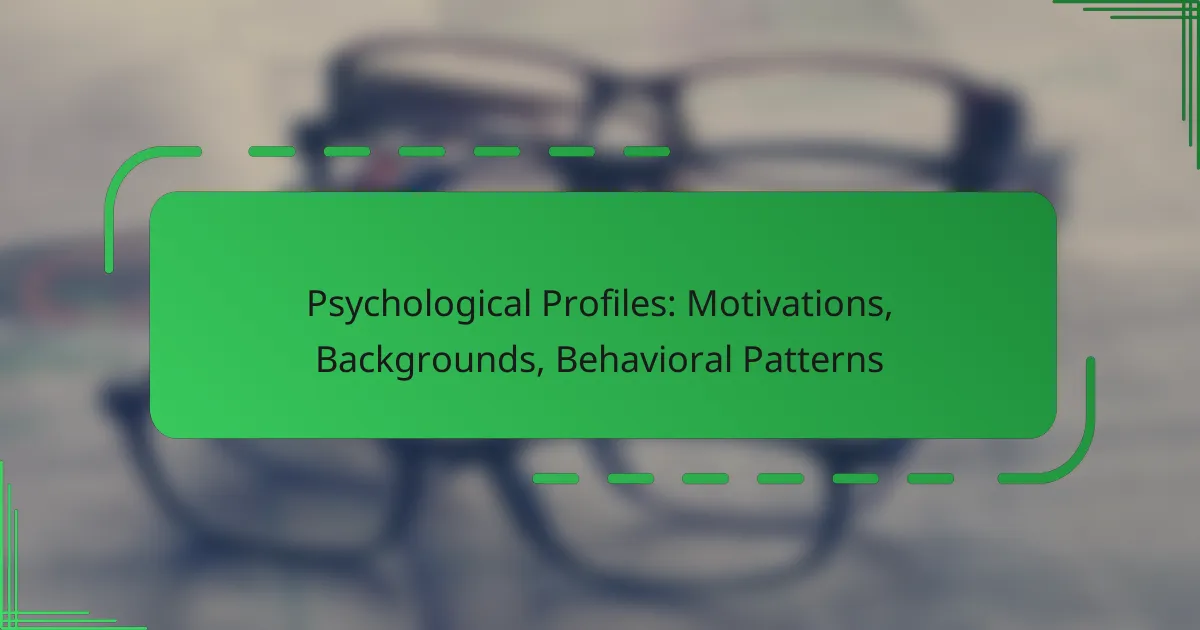Psychological profiles provide valuable insights into the motivations, backgrounds, and behavioral patterns of individuals. By examining intrinsic and extrinsic factors, as well as social and cultural influences, we can better understand how personal experiences shape behavior. Additionally, recognizing common decision-making styles and communication preferences allows for improved interpersonal interactions and predictions of responses in various situations.

What are the key motivations behind psychological profiles?
The key motivations behind psychological profiles include intrinsic and extrinsic factors, social influences, cultural contexts, and personal experiences. Understanding these motivations helps in analyzing behavior patterns and predicting responses in various situations.
Intrinsic motivations
Intrinsic motivations stem from internal desires, such as personal growth, curiosity, and the pursuit of knowledge. Individuals driven by intrinsic factors often engage in activities for the sheer enjoyment or satisfaction they provide, rather than for external rewards.
For example, a person may choose to learn a new language because they find it intellectually stimulating, rather than for a job requirement. Recognizing intrinsic motivations can lead to more fulfilling personal and professional experiences.
Extrinsic motivations
Extrinsic motivations are influenced by external rewards or pressures, such as money, recognition, or social approval. These factors can significantly impact behavior, often driving individuals to achieve specific goals to gain rewards or avoid negative consequences.
For instance, an employee may work overtime to receive a bonus or promotion. While extrinsic motivations can be effective in driving short-term behavior, they may not lead to long-term satisfaction if not balanced with intrinsic factors.
Social influences
Social influences encompass the effects of family, friends, and societal norms on an individual’s motivations and behaviors. People often adjust their actions to align with the expectations or behaviors of those around them.
For example, a student may choose a particular career path based on parental expectations or peer pressure. Understanding these social dynamics can help in recognizing how group behavior shapes individual motivations.
Cultural factors
Cultural factors play a crucial role in shaping motivations by establishing values, beliefs, and practices within a society. Different cultures may prioritize various motivations, influencing how individuals perceive success and fulfillment.
For instance, collectivist cultures may emphasize community and family-oriented goals, while individualistic cultures may focus on personal achievement. Awareness of cultural influences can enhance cross-cultural understanding and improve interpersonal interactions.
Personal experiences
Personal experiences, including past successes and failures, significantly shape an individual’s motivations. These experiences can create strong emotional responses that influence future behavior and decision-making.
For example, someone who has overcome adversity may be motivated to help others facing similar challenges. Reflecting on personal experiences can provide valuable insights into one’s motivations and guide future actions effectively.

How do backgrounds influence psychological profiles?
Backgrounds significantly shape psychological profiles by affecting motivations, behaviors, and emotional responses. Factors such as education, socioeconomic status, family dynamics, and geographic location contribute to how individuals perceive the world and interact with others.
Educational background
Educational background plays a crucial role in forming psychological profiles. Individuals with higher education levels often exhibit different cognitive styles and problem-solving approaches compared to those with less formal education. For example, a person with a degree in psychology may have a more analytical mindset and greater emotional intelligence.
Moreover, access to educational resources can influence self-esteem and ambition. Those who attended prestigious institutions may feel more confident in their abilities, while others might struggle with feelings of inadequacy.
Socioeconomic status
Socioeconomic status (SES) profoundly impacts psychological profiles by shaping access to resources and opportunities. Individuals from higher SES backgrounds often experience less stress related to financial insecurity, which can lead to healthier coping mechanisms and better mental health outcomes.
Conversely, those from lower SES backgrounds may face challenges such as limited access to healthcare and education, which can contribute to feelings of hopelessness or anxiety. Understanding these dynamics is essential for tailoring support and interventions.
Family dynamics
Family dynamics significantly influence psychological profiles, as they establish early patterns of behavior and emotional responses. Supportive family environments foster resilience and positive self-image, while dysfunctional family relationships can lead to issues such as low self-esteem or difficulty in forming healthy relationships.
For instance, individuals raised in nurturing households may develop strong communication skills, whereas those from conflict-ridden families might struggle with trust and intimacy. Recognizing these patterns can aid in personal development and therapy.
Geographic location
Geographic location affects psychological profiles by influencing cultural norms, social interactions, and access to services. Urban residents may experience different stressors and social dynamics compared to those in rural areas, impacting their mental health and coping strategies.
For example, individuals in metropolitan areas might face fast-paced lifestyles and heightened competition, while those in rural settings may deal with isolation. Understanding these geographic influences can help in creating targeted mental health resources and community support systems.

What behavioral patterns are common in psychological profiles?
Common behavioral patterns in psychological profiles include distinct decision-making styles, communication preferences, conflict resolution strategies, and work habits. Understanding these patterns helps in predicting behaviors and improving interpersonal interactions.
Decision-making styles
Decision-making styles vary widely among individuals, often influenced by their psychological profiles. Some may rely on analytical thinking, weighing pros and cons, while others might favor intuitive approaches, trusting their gut feelings. Recognizing these styles can enhance collaboration and reduce misunderstandings.
For example, a person with a rational decision-making style might take longer to reach a conclusion, as they analyze data thoroughly, whereas an intuitive decision-maker may arrive at conclusions quickly based on their instincts. Understanding these differences can help teams balance speed and thoroughness in decision-making.
Communication preferences
Communication preferences reflect how individuals express themselves and interpret messages from others. Some people prefer direct, straightforward communication, while others may lean towards a more nuanced, indirect style. Identifying these preferences can improve clarity and reduce friction in conversations.
For instance, a direct communicator may appreciate concise emails, while an indirect communicator might prefer a more detailed context. Adapting communication styles to match preferences can foster better relationships and enhance teamwork.
Conflict resolution strategies
Conflict resolution strategies are essential for managing disagreements effectively. Individuals may adopt various approaches, such as avoidance, accommodation, competition, compromise, or collaboration. Each strategy has its advantages and drawbacks, depending on the situation and the parties involved.
For example, collaboration often leads to win-win outcomes but may require more time and effort, while avoidance might provide temporary relief but can exacerbate issues in the long run. Understanding one’s own strategy and that of others can facilitate more constructive conflict management.
Work habits
Work habits encompass how individuals approach tasks and manage their time. Some may thrive in structured environments with clear deadlines, while others prefer flexibility and spontaneity. Recognizing these habits can enhance productivity and job satisfaction.
For instance, a person with a structured work habit may excel in roles requiring meticulous planning, whereas someone with a flexible approach might be better suited for creative or dynamic tasks. Tailoring work environments to accommodate different habits can lead to improved performance and morale.

How can psychological profiles be assessed effectively?
Psychological profiles can be assessed effectively through a combination of standardized tests, interviews, surveys, and behavioral observations. Each method provides unique insights into an individual’s motivations, backgrounds, and behavioral patterns, allowing for a comprehensive understanding of their psychological makeup.
Standardized tests
Standardized tests are structured assessments designed to measure specific psychological traits and abilities. These tests often include personality inventories, intelligence tests, and aptitude assessments, providing quantifiable data that can be compared across populations.
Common examples include the Myers-Briggs Type Indicator (MBTI) and the Minnesota Multiphasic Personality Inventory (MMPI). When using standardized tests, ensure they are validated for the target population to maintain accuracy and relevance.
Interviews and surveys
Interviews and surveys are qualitative methods that gather personal insights directly from individuals. Structured interviews follow a predetermined set of questions, while surveys can include open-ended questions to allow for more nuanced responses.
These methods can reveal motivations and backgrounds that standardized tests may overlook. It’s essential to create a comfortable environment to encourage honest and reflective answers, which can lead to richer data.
Behavioral observations
Behavioral observations involve monitoring an individual’s actions in various contexts to gain insights into their behavior patterns. This method can be particularly useful in natural settings, such as workplaces or social gatherings, where spontaneous behaviors can be assessed.
When conducting behavioral observations, focus on specific behaviors relevant to the psychological profile being assessed. Documenting behaviors over time can help identify consistent patterns and inform conclusions about an individual’s psychological state.

What frameworks exist for understanding psychological profiles?
Several frameworks help analyze psychological profiles, focusing on various aspects like personality traits, motivations, and behavioral patterns. These models provide insights into how individuals think, feel, and behave, aiding in personal development and interpersonal relationships.
Big Five personality traits
The Big Five personality traits, also known as the Five Factor Model, include openness, conscientiousness, extraversion, agreeableness, and neuroticism. This framework categorizes individuals based on these five dimensions, offering a comprehensive view of personality.
Each trait represents a spectrum. For instance, someone high in openness may be imaginative and open to new experiences, while a person low in this trait may prefer routine and familiarity. Understanding where someone falls on these scales can help predict their behavior in various situations.
To apply this model, consider using self-assessment tools or personality tests that measure these traits. Be cautious of overgeneralizing based on results; personality is complex and can change over time or in different contexts. Aim for a balanced view that considers both strengths and areas for growth.



